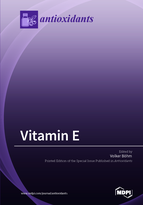Vitamin E
A special issue of Antioxidants (ISSN 2076-3921). This special issue belongs to the section "Natural and Synthetic Antioxidants".
Deadline for manuscript submissions: closed (31 October 2017) | Viewed by 99385
Special Issue Editor
Interests: dietary antioxidants; carotenoids; polyphenols; vitamin E; vitamin C; antioxidant activity/capacity; interactions; bioavailability
Special Issues, Collections and Topics in MDPI journals
Special Issue Information
Dear Colleagues,
The purpose of this Special Issue of Antioxidants is to present recent investigations on the role of vitamin E as antioxidant in health promotion or disease prevention, as well as results on non-antioxidant activities of vitamin E. It is also important to show recent developments for vitamin E in structural characterization of bioactive, endogenous metabolites, and the use of vitamin E in industry.
Vitamin E was first described in 1922 as a necessary dietary factor for reproduction in rats. In contrast to most other vitamins showing a cofactor function or a unique molecular role, such a specific vitamin E function, has not yet been shown. Vitamin E is an important lipophilic antioxidant, protecting, e.g., long-chain polyunsaturated fatty acids in cell membranes. In food, there are four tocopherols and four tocotrienols. In contrast, the most important compound in vivo is α-tocopherol. The hepatic α-tocopherol transfer protein is one reason for this discrimination. Another explanation is the preferential metabolism of non-α-tocopherol congeners by ω-hydroxylation and β-oxidation. Recent investigations showed interesting biological activities of long-chain metabolites (e.g., α-13’-carboxychromal) of vitamin E.
Therefore, you are invited to submit original research papers or review articles, focused on all issues related to vitamin E.
Prof. Dr. Volker Böhm
Guest Editor
Manuscript Submission Information
Manuscripts should be submitted online at www.mdpi.com by registering and logging in to this website. Once you are registered, click here to go to the submission form. Manuscripts can be submitted until the deadline. All submissions that pass pre-check are peer-reviewed. Accepted papers will be published continuously in the journal (as soon as accepted) and will be listed together on the special issue website. Research articles, review articles as well as short communications are invited. For planned papers, a title and short abstract (about 100 words) can be sent to the Editorial Office for announcement on this website.
Submitted manuscripts should not have been published previously, nor be under consideration for publication elsewhere (except conference proceedings papers). All manuscripts are thoroughly refereed through a single-blind peer-review process. A guide for authors and other relevant information for submission of manuscripts is available on the Instructions for Authors page. Antioxidants is an international peer-reviewed open access monthly journal published by MDPI.
Please visit the Instructions for Authors page before submitting a manuscript. The Article Processing Charge (APC) for publication in this open access journal is 2900 CHF (Swiss Francs). Submitted papers should be well formatted and use good English. Authors may use MDPI's English editing service prior to publication or during author revisions.
Keywords
- Vitamin E
- Absorption, metabolism and bioavailability
- Pharmacokinetics
- Antioxidant mechanisms
- Non-antioxidant activities
- Health and disease
- Industrial uses
- Functional properties
- Extraction and chemical characterization of metabolites







